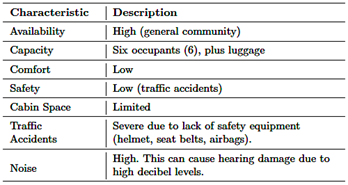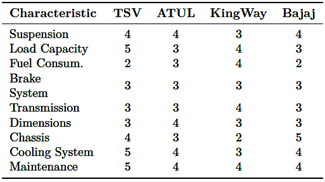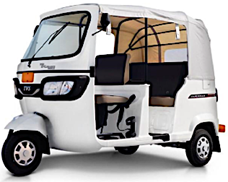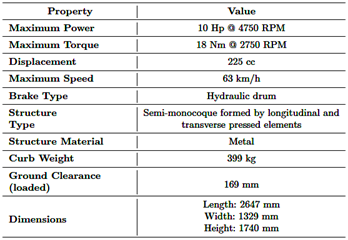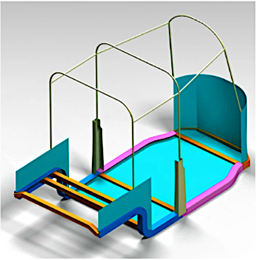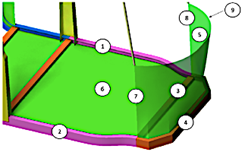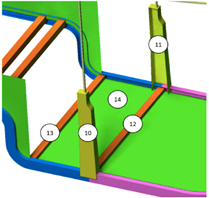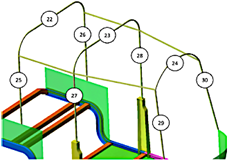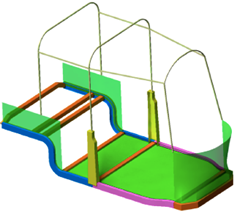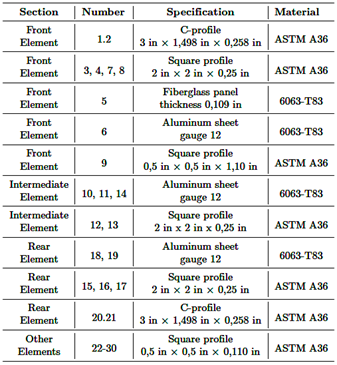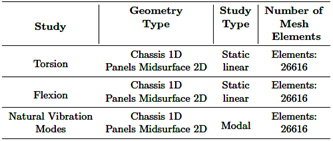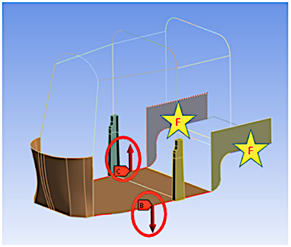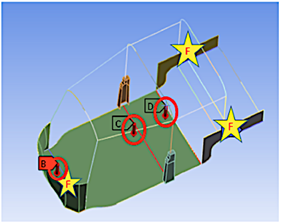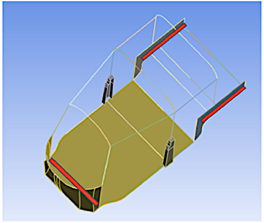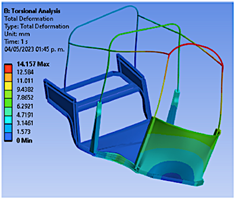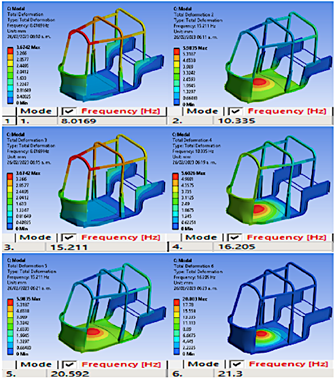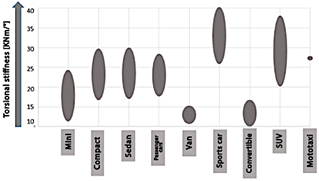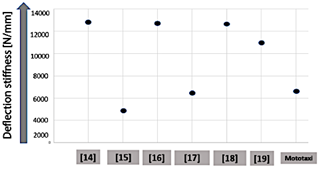|
Scientific Paper / Artículo Científico |
|
|
|
|
https://doi.org/10.17163/ings.n32.2024.02 |
|
|
|
pISSN: 1390-650X / eISSN: 1390-860X |
|
|
STRUCTURAL EVALUATION OF A THREE-WHEELER VEHICLE USING SIMULATION
TOOLS: A CASE STUDY IN MEXICO |
||
|
EVALUACIÓN ESTRUCTURAL DE UN VEHÍCULO TIPO MOTOTAXI USANDO HERRAMIENTAS DE SIMULACIÓN: CASO MÉXICO |
||
|
Received: 14-05-2023, Received after review: 28-03-2024, Accepted:
23-04-2024, Published: 01-07-2024 |
|
Abstract |
Resumen |
|
The mototaxi, a three-wheeled vehicle equipped with a roof,
is a widely utilized mode of transportation in Mexico. Typically, it is
employed for short-distance journeys in exchange for payment, similar to the operation of a conventional taxi. This
study conducts a structural analysis of a mototaxi-type
vehicle utilized in Mexico to assess its performance and safety. It
underscores the significance of this mode of transportation, widely relied
upon by numerous individuals. A product design and development methodology was employed, utilizing torsional deformation simulations
to validate the new geometry. The objective was to minimize torsions as much
as possible, thereby enhancing the motorcycle taxi’s safety and ensuring the
vehicle’s correct positioning. Through computeraided
design, the prevailing torsions within the casing were assessed, establishing
the operating conditions to which the system is commonlysubjected.
The findings from the chosen vehicular structure reveal a flexural rigidity
of 6,508.15 N/mm, torsional rigidity of 27.35 KNm/º,
and a range of natural frequencies between 8-21 Hz. These values indicate
favorable resistance against bending forces and operational frequency.
However, the torsional results exhibit deficiencies, suggesting an unsafe
structure for all motorcycle taxi occupants. Consequently, technology
developers and national legislators should prioritize enhancing the
structural integrity of such vehicles. |
El mototaxi es un vehículo de tres ruedas y con techo que se usa como medio de transporte popular en México, generalmente para recorrer caminos cortos a cambio de dinero, de la misma forma que opera un taxi. Esta investigación presenta el análisis estructural de un vehículo tipo mototaxi empleado en México, para evaluar su desempeño y seguridad, teniendo en cuenta que es un medio de transporte utilizado por muchas personas. Se empleó una metodología de diseño y desarrollo de producto, utilizando simulaciones de deformación torsionales para validar la nueva geometría, minimizando las torsiones en lo posible, tratando de mejorar la seguridad del mototaxi, así como la posición correcta del vehículo. Mediante el diseño asistido por computadora se probaron las torsiones existentes en la carcasa, determinando las condiciones de operación por las que generalmente es sometido el sistema.Los resultados obtenidos en la estructura vehicular seleccionada son para la rigidez por flexión de 6508,15 N/mm, la rigidez torsional de 27,35 KNm/º y el rango de frecuencias naturales en 8-21 Hz, valores que muestran que la estructura presenta condiciones favorables mediante esfuerzos de resistencia por flexión y la frecuencia de operación de la estructura, pero carencias en los resultados torsionales, generando así una estructura insegura para los ocupantes del mototaxi. Es necesario que los desarrolladores de tecnología como los legisladores nacionales actúen en favor de mejorar sus condiciones estructurales. |
|
Keywords: Structural, mototaxi,
safety, ANSYS, CAE, simulation |
Palabras clave: estructural, mototaxi, seguridad, ANSYS, CAE, simulación |
|
1,*Facultad de Ingeniería
Industrial, Logística, Manufactura y Automotriz, Universidad Popular Autónoma
del Estado de Puebla, México.Corresponding author ✉: josejesus.cordero@upaep.mx. 2Benemérita
Universidad Autónoma de Puebla – México. Suggested citation: Cuautle Gutiérrez, L.; Cordero Guridi, J. J.; Olivares Rojas, J. E. and Pena Preza, N. “Structural Evaluation of a Three-Wheeler Vehicle Using Simulation Tools: A Case Study in Mexico,” Ingenius, Revista de Ciencia y Tecnología, N.◦ 32, pp. 18-26, 2024, doi: https://doi.org/10.17163/ings.n32.2024.02. |
|
1.
Introduction The insufficient
supply and restricted public transportation coverage in developing countries
have prompted the emergence of mototaxism in
numerous cities worldwide, wherein motorcycles are utilized as a form of
public transportation. A
mototaxi, characterized by its three-wheeled
structure and roof, is a cost-effective means for individuals to fulfill
their mobility requirements, akin to traditional taxis. It fills a unique
niche in transportation services, catering to entire journeys and the initial
and final segments of trips in densely populated, congested, or otherwise
inaccessible areas. These trips are often too lengthy and challenging to
traverse by foot yet fall short of commercial viability for conventional
public transportation modes. The
inception of the mototaxi occurred in Paris in
1999, representing an innovative and efficient transportation solution aimed
at addressing the travel requirements of passengers commuting between the
city’s two airports [1]. For
approximately two decades, this mode of transportation has been present in
Mexico City and various states of the Republic, predominantly in the form of
motorcycles equipped with a canopy and cabinincorporated
motocarros [2]. The
mototaxi caters to particular yet
unfulfilled transportation demands and functions more as a supplementary
service than a direct competitor to other public transportation modes. Its
primary advantage lies in its lightweight construction, speed, and ease of
parking, enabling users to traverse short distances more efficiently.
According to the National Institute of Statistics and Geography, over 273,000
mototaxi trips occur daily in Mexico City and its
metropolitan region, constituting 3.7% of all public transportation. journeys
[3]. In
Juchitán de Zaragoza, Oaxaca, Mexico, the King
model is frequently employed as a mototaxi owing to
its versatile chassis, instrumentation, engine, power, and torque
capabilities. This model achieves a maximum speed of 56 kilometers per hour
and has a curb weight of 300 kilograms [4]. Mototaxis belong to the classification of small motor
vehicles, alongside mopeds, scooters, motorcycles, motorized tricycles, quad
bikes, and analogous vehicles [5]. The
mototaxi industry grapples with numerous
challenges, encompassing congestion, road infrastructure, regulatory
standards, and safety considerations [6]. |
On a global scale, the utilization of mototaxis has adversely affected the environment, social
dynamics, and road safety. The adverse environmental impacts primarily
stem from pollutant emissions resulting from inadequate vehicle maintenance
and the use of low-quality fuel [7]. In the State of Mexico, mototaxis
serve as sources of informal employment for both men and women, offering an
average weekly income of $1236 to drivers. These drivers typically possess a
secondary or high school education, with common-law marriage being the most
prevalent marital status [8]. Puebla has over ten thousand estimated mototaxi drivers across over sixty municipalities [9]. Regarding road safety issues, mototaxis are responsible for numerous severe traffic
accidents. Table 1 presents some characteristics of
these vehicles that highlight the safety issues associated with them. Table 1. Characteristics of Mototaxis
Moreover, the chassis is commonly regarded as
the vehicle’s skeleton, as it accommodates the components necessary for
proper operation. The chassis must possess sufficient strength to withstand
impacts, torsion, vibrations, and other stresses encountered during
operational activities. Another crucial aspect concerns legislation,
as all vehicles operating on public roads must adhere to specific regulations
established by some institutions and laws. In numerous Mexican states, mototaxis remain largely unregulated. However, in the
state of Puebla, guidelines governing mototaxis are
outlined in the transportation law, particularly in articles 12 and 37 [10]. Hence, this study aims to assess the
structural integrity of this mode of transportation to ascertain the level of
safety provided by service providers to their users. |
|
2.
Materials and
method A product design and
development methodology was employed to assess the
performance and safety of the mototaxi-type
vehicle, utilizing a digital model of the three-wheeled vehicle structure.
The study proceeded through the following phases: benchmarking, technical
characterization, development of the analysis model, and structural
evaluation. Four
prominent brands in Mexico, including TSV, ATUL, KingWay,
and Bajaj and their primary models were examined during the benchmarking
phase. Eight key characteristics were analyzed, including maximum power,
maximum torque, fuel consumption, load capacity, brakes, chassis, and
stabilizer bar, as detailed in Table 2. Table 2. Evaluation of Mototaxi Brands
Using
the acquired data, each vehicle underwent an evaluation to ascertain the one
possessing superior attributes. In this subsequent phase, nine
characteristics were considered as delineated by the authors. Ratings were
assigned on a 5-point scale, with 1 representing deficiency and 5 indicating
optimal performance, as outlined in Table 2. The TSV brand, specifically the
King Duramax model, attained the highest score. The
ratings were determined through consensus among the authors. Based on the averaged scores, the King Duramax was selected with a
rating of 3.71. It is noteworthy that the results were closely aligned, as
the four models under scrutiny exhibited very comparable characteristics and
performance, thereby sharing similar attributes. In
the technical characterization, the TVS Group, an Indian company ranking
third globally, is India’s largest manufacturer of two-wheeled vehicles, with
its products being exported to over sixty countries. Renowned for delivering
high-quality vehicles that cater to customer requirements, TVS has
established Motocarros TVS in Mexico. This branch,
dedicated to the distribution of three-wheeled vehicles, operates under
Kawasaki with the backing of Grupo Motomex. The
selected unit was the King Duramax 2020, shown in Figure 1. |
Based on the obtained data, each vehicle was
rated to determine the one with the best qualities. For this new stage, nine
characteristics defined by the authors were considered. The ratings were on a
5-point scale where 1 is deficient and 5 is optimal, as presented in Table 2.
The highest score was obtained by the TSV brand, with the King Duramax model. The ratings were assigned by consensus among
the authors. According to the averages obtained, the King Duramax was chosen
with a score of 3.71. It is important to mention that the results were very
close because the four analyzed models have very similar characteristics and
performance, thus having similar elements. In the technical characterization, the TVS
Group, an Indian company that ranks third, is the largest manufacturer of
two-wheeled vehicles in India, currently exporting to more than sixty
countries. It is a company known for offering quality vehicles that
anticipate customer needs. In Mexico, Motocarros
TVS, the branch dedicated to the commercialization of three-wheeled vehicles,
is part of Kawasaki with the support of Grupo Motomex. The chosen unit was the King Duramax 2020, as
illustrated in Figure 1.
Figure 1. King Duramax 2020 [11]. Table 3 presents some of its technical
features. Table 3. Technical
Characteristics of the King Duramax 2020
|
|
During
the development stage of the CAD analysis model, CAD and CAE software,
including CATIA V5 2020 and Ansys 2020, were utilized. A
similar configuration model was proposed using the data collected from the mototaxi benchmarking. It comprised a semi-monocoque
structure constructed from longitudinal and transverse pressed elements,
commonly referred to as a ladder frame or chassistype
structure, as depicted in Figure 2.
Figure 2. Ladder or Chassis Type
Automotive Structure Considering
the information from the TVS manufacturer, a model comprising 30 components
was developed. These components primarily encapsulate those pertinent and
indispensable for analysing the vehicle’s
structure, including chassis elements, lower panels, and select exterior
panels, as depicted in Figure 3.
Figure 3. CAD Model of the Structure Figure
4 depicts the structure’s frontal components, featuring the removal of the
front panel to expose the chassis components and panels. |
Figure 4. Front Chassis
Elements Figure 5 illustrates the intermediate
elements of the vehicle, highlighting the "posts" and components
responsible for supporting the passengers.
Figure 5. Intermediate
Chassis Elements Figure 6 illustrates the rear section of the
structure with the components that accommodate mechanical elements like the
engine system and rear suspension, along with the rear panels and the rear
impact bar.
Figure 6. Rear Chassis Elements |
|
Furthermore,
additional minor pertinent elements were included in the vehicle evaluation,
characterized by a roof structure possessing the following properties, as
illustrated in Figure 7.
Figure 7. Estructura superior del techo Ultimately,
Figure 8 displays the final model intended for structural analysis. This
model exclusively incorporates the elements utilized in the CAE evaluation of
the vehicle.
Figure
8.
Global View of the Mototaxi Model for Structural
Evaluation Table
4 presents the various components utilized along with their descriptions,
particularly regarding the type of profile employed for structural
evaluation. For
the vehicle evaluation, several materials were initially explored for the
modeled elements to ensure optimal outcomes. ASTM A36 steel and 6063-T83
aluminum alloy were chosen for their established applications in automotive
structures and panels [12]. Considering this, three studies were proposed using ANSYS software to assess torsional rigidity, flexural rigidity, and natural vibration modes. The pertinent global variables are outlined in Table 5. |
Table
4.
Specification of Selected Components in the Mototaxi
Structure
Table 5. Technical
Specification of Considered Global Variables
Figure 9 illustrates the applied constraints
(depicted by stars labeled with the letter F) and the utilized loads (vectors
identified with annotations B and C inside circles) for the torsion analysis
of the structure, along with the obtained deformation values. The load values
were determined by prioritizing loads that closely mimic real-world
conditions, as specified in Table 6. Table 6. Specification of Load
Locations on the Primary Structure of the Mototaxi
for Study
|
|
Figure
9.
Global View of the Mototaxi Model Representing
Applied Loads for Study Given
the possibility of mototaxi operators occasionally
overloading the structure, it is imperative to ascertain its resistance to
torsional forces. Consequently, investigations were conducted using a maximum
load capacity of six individuals, each weighing an average of eighty kilograms,
resulting in a total of 4708 N, distributed in two sections. These revised
values were then applied to the lateral areas of the mototaxi
structure in opposite directions to assess and validate the newly acquired
results. Figure
10 illustrates the applied constraints (depicted by stars labeled with the
letter F) and the utilized loads (directional vectors annotated with B, C,
and D enclosed in circles) for the flexural analysis of the structure, from
which deformation values are derived.
Figure 10. Constraints in
the Flexural Analysis For
the flexural analysis, the maximum load capacity that the primary structure
can sustain was considered, amounting to seven individuals, each averaging
eighty kilograms. Consequently, with a total load of 560 kilograms, this
value is distributed among the three beams depicted in the figure, resulting
in a distribution of 5494 N among the three beams represented. For the modal study, the analysis focused on examining the six natural vibration modes of the model. Figure 11 illustrates the positional constraints applied to |
the vehicle structure for this analysis. Table 7 specifies the type of
restraints employed in the study.
Figure 11. Positional
Constraints Table 7. Specification of Load
Locations on the Primary Structure of the Mototaxi
for Study
3.
Results and
Discussion Figure 12 illustrates the torsional deformation induced by the
previously described loads.
Figure 12. Global View of the Mototaxi Model Representing the Results of Torsional
Loads As depicted in Table 8, a torsional rigidity value of 27.35 KNm/º was derived from the applied torsional load and a measured structural torsion angle of 0.27251°. Furthermore, the maximum observed deformation amounts to 14.157 mm.
|
|
Table 8. Torsional Evaluation
Results
For
flexural rigidity, Figure 13 depicts the observed deformationin
the mototaxi structure.
Figure
13. Global View of the Mototaxi Model
Representing the Results of Flexural Loads The
maximum observed deformation is 0.84424 mm, leading to a flexural rigidity
value of 6508.15 N/mm. As for the modal analysis of the mototaxi
structure, Figure 14 illustrates the various vibration modes of the analyzed
structure. As part of this assessment, the typical engine operating
revolutions of the vehicle were identified, with an operational frequency
determined to be 88 Hz. In
Table 9, the numerical values found in the vibration modes of the structure
are described. Table 9. Modal Evaluation
Results
To
ascertain the suitability of the acquired torsion and flexion values for the
analyzed structure, the comparison by Hirz was employed
as a reference. This comparison encompasses nine distinct categories,
detailing specific ranges of torsional stresses for each category [13]. |
Figure 14. Global View of the Mototaxi Model Representing the Results of Applied Loads
for Study In the analysis of the mototaxi,
the categories primarily considered were "mini car," "compact
car," and "convertible," facilitating a comparable assessment.
Particular emphasis was placed on the
"convertible" category due to the mototaxi’s
configuration. Given its structural design primarily in the lower part, it
bears a strong resemblance to the "convertible" category. Based on the analysis depicted in Figure 15,
it is evident that the structure exhibits greater torsional rigidity compared
to the "convertible" category, which typically ranges from 10 to 17
KNm/º, while the mototaxi
demonstrates a value of 27.35 KNm/º. As for
flexural rigidity, a similar comparison was conducted with analogous
structures from diverse studies, and Figure 16 displays six different studies
[14–19] along with their respective values.
Figure 15. Comparison of
Structural Torsion Resistance Results |
|
Figure 16. Comparison of Flexural
Rigidity Results When
comparing flexural stresses, it is evident that the mototaxi
structure exhibits a value of 6508.15 N/mm. The reviewed studies reveal
comparable values, suggesting that the structure behaves similarly (with
values ranging from 5 to 13 KN/mm) to other studies evaluatingflexural
rigidity. 4.
Conclusions The
conducted studies comprehensively assessed the performance of the vehicle
structure across three primary criteria: flexural rigidity, torsional
rigidity, and modal evaluation. The meticulous analysis of the calculated
values and comparisons revealed that the mototaxi-type
structure exhibits notable concerns regarding structural integrity. These
concerns were underscored by observable deviations compared to similar
structures in the vehicle’s torsional studies. This discrepancy hints at
potential structural behavioral issues during operation, possibly stemming
from the absence of an integrated structure, including the roof. Consequently,
this deficiency impairs the structure’s performance efficiency, diminishing
energy absorption and dissipation capacity. Notably, the flexural studies of
the structure yielded values closely aligned with those of comparable
structures. In contrast, the modal evaluation revealed a lack of alignment
between the natural frequencies and the operational frequency of the
vehicle’s components, thus indicating inadequacies under these criteria. Similarly,
A. Rodríguez [20] analyzed a tricycle structure under defined parameters and
specified load cases. Unlike the aforementioned studies,
which primarily focused on assessing the structure’s failure and fatigue
criteria, this investigation focused on evaluating the vehicle’s response
under static working conditions. Future work could encompass evaluations
incorporating relevant failure criteria and dynamic behavior analyses,
thereby addressing potential |
hazards associated with frontal and lateral
collisions or rollovers. While vehicles of this class were primarily
developed to provide an economical mobility option for both users and
operators, the structure of mototaxis poses risks
to the safety of passengers. It is imperative for local and national
legislation, as well as developers of this vehicle technology, to enhance its
structural and dynamic conditions. References
[1] B. A. A. López, N. D. L. Ledón, J. A. González, and J. E. D. Reinoso, “Mototaxis como medio de transporte público en el municipio de San Blas, Nayarit,” Universo de la Tecnología, vol. 1, no. 43, pp. 25–31, 2023. [Online]. Available: https://bit.ly/3UoAe9Q [2] N. Ortuya.
(2023) Mototaxi en méxico: ¿una buena alternativa
de trnasporte? Autofact. Autofact.
[Online]. Available: https://bit.ly/3QoFold [3] M. Sánchez. (2019) Están prohibidos, pero los mototaxis llevan a la gente a donde tiene que ir. Global Press Journal. Global Press Journal. [Online]. Available: https://bit.ly/3JGoRFi [4] M. J. Solís, C. A. López, and R. Gómez, “El mototaxi como medio de transporte público en Juchitán de Zaragoza, Oaxaca,” Centro Educativo Cruz Azul, 2016. [Online]. Available: https://bit.ly/3WghKuR [5] DRTCSanMartin, Manual del conductor, Capítulo 6: El Vehículo. Dirección Regional de Transportes y Comunicaciones de San Martín. Perú, 2021. [Online]. Available: https://bit.ly/4aUO9vz [6] Z. J. Chan, V. Hung, and K. Kallmyer, Inclusión social y movilidad: el sector del mototaxi en Tarapoto (Perú), 2019. [Online]. Available: https://bit.ly/44mbsvA [7] L. Diaz Olvera, D. Plat, P. Pochet, and M. Sahabana, “Un transporte urbano no convencional en áfrica subsahariana: el mototaxi,” Revista VIAL, pp. 52–54, 01 2011. [Online]. Available: https://bit.ly/3QCLgr8 [8] J. L.
Bernal López, “El autoempleo en el transporte informal como forma de exclusion social: el caso de los mototaxistas del
municipio de chimalhuacán,” Análisis económico,
vol. 36, no. 93, pp. 141–158, 2021. [Online]. Available: https://doi.org/10.24275/uam/azc/dcsh/ae/2021v36n93/Bernal [9] B. Barrios Hernández and P. F. Coutiño Osorio, “El servicio de mototaxis: una fuente alternativa de trabajo en Puebla,” DIKE, no. 15, pp. 157–171, 2014. [Online]. Available: http://dx.doi.org/10.32399/fder.rdk.25940708.2014.15.168 |
|
[10] Congreso de Puebla, Ley de movilidad y transporte del Estado de Puebla. Honorable Congerso del Estado de Puebla, 2021. [Online]. Available: https://bit.ly/4a5ZxDn [11] MSM, Ficha técnica: Motor de encendido por chispa de 4 tiempos,
refrigerado por liquido. Moto Soluciones
México, 2023. [Online]. Available: https://bit.ly/3JQSAvl [12] C. Okpala, T. Nwokeocha, L. Ofuoku, A. Akajiugo, and J. Adonu, “Design
and analysis of chassis and spring of a load- bearing tricycle,”
International Journal of Advanced Engineering Technology, vol. 8, no. 3, pp.
10–15, 2017. [Online]. Available: https://bit.ly/3WxEbMi [13] M. Hirz. (2016)
What are the typical stiffness values while designing car chassis?.
ReserachGate. ReserachGate.
[Online]. Available: https://bit.ly/3wqmMKC [14] D. Fang and W. Kefei, “Simulation analysis and experimental verification
on body-in-white static stiffness of a certain commercial vehicle,” Vibroengineering PROCEDIA, vol. 29, pp. 141–147, nov 2019. [Online]. Available: https://doi.org/10.21595/vp.2019.21171 [15] H. J. Yan, X. Liu, G. Q. Zhao, N. Tian, and S. K. zhang, “Analysis and Research of Stiffness Based on Body-in-White NVH,” Journal of Physics: Conference Series, vol. 1087, no. 4, p. 042078, sep 2018. [Online]. Available: https://dx.doi.org/10.1088/17426596/1087/4/042078 |
[16] Z. Wentao,
W. Zhenhu, F. Xiangdong,
Y. Xuyue, L. Luoxing, and
W. Wanlin, “A calculation method of car body in
white’s static stiffness based on modal theory,” China Mechanical
Engineering, vol. 29, no. 5, pp. 511–518, 2018. [Online]. Available: https://bit.ly/4a7wkYN [17] C. Hartmann, M. Welm, S.
Schreyer, C. Hartmann, and W. Volk, “A modular car body for sustainable,
cost-effective, and versatile vehicle development,” Technologies, vol. 9, no.
1, 2021. [Online]. Available: https://doi.org/10.3390/technologies9010013 [18] M. H. Shojaeefard,
A. Khalkhali, M. Sarmadi,
and N. Hamzehi, “Investigation on the optimal
simplified model of BIW structure using FEM,” Latin American Journal of
Solids and Structures, vol. 12, no. 10, pp. 1972–1990, Oct 2015. [Online].
Available: https://doi.org/10.1590/1679-78251923 [19] M. M. Shivakumar and L.
Nirmala, “Fatigue life estimation of chassis frame fesm
bracket for commercial vehicle,” International Journal of Science and
Research (IJSR), vol. 3, no. 8, pp. 441–447, 2014. [Online]. Available: https://bit.ly/4brALP9 [20] A. Rodríguez, B. Chiné, J. A. Ramirez, and Costa, “Finite element modeling of an aluminum tricycle frame,” 2016. [Online]. Available: https://bit.ly/4aqmFwR |
